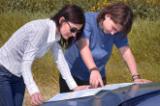Greenprinting - Trust for Public Land
Trust for Public Land's Greenprinting priority framework focuses on creating both a vision for future growth and a plan to protect a community's important natural resources.
Local governments and their private partners use Greenprinting to preserve the services and amenities their community depend upon -- drinking water sources, recreational lands, natural areas, open spaces -- and steer growth around them.
In the process, these communities redirect development toward existing infrastructure, realize fiscal benefits, and improve quality of life. Land conservation then becomes a powerful and cost-effective growth management tool -- an equal partner with traditional regulatory, zoning, and planning approaches.
As developed by the Trust for Public Land, greenprinting follows these steps:
Step 1: Defining a Conservation Vision
Developing a land protection vision that reflects a community’s smart-growth goals and enjoys public support
Step 2: Securing Conservation Funds
Identifying and securing federal, state, local, and private open space protection funds.
Step 3: Acquiring and Managing Park and Conservation Lands
Administering the greenprinting program, completing transactions, and managing protected lands.
TPL has worked with dozens of local governments across the nation on land conservation programs that preserve community character, create savings in local budgets, stimulate economic development, and attract and keep new residents. Land conservation can play a key role in building a sense of community.
Learn more about Greenprinting and other services from at TPL's Conservation Vision website
Featured Greenprints
-
King County Greenprint - Trust for Public Land
by Trust for Public Land
TPL worked with King County experts to develop a customized, interactive GIS-based decision-making tool that allows the county to target its limited resources to the most critical lands.
Go Straight to Your State
Learn about conservation and open space in your state.




